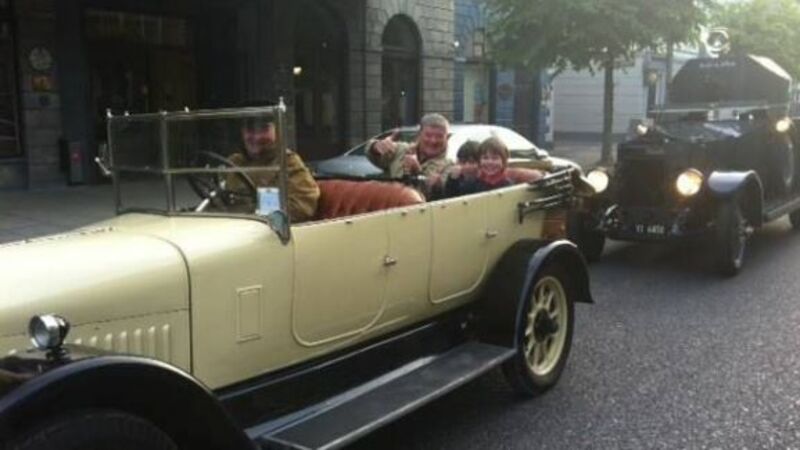Retracing the Big Fellow’s final steps

TELLING the tale of Michael Collins’s last journey was as much delight as duty for RTÉ presenter John Creedon, but he knows what the payola will be.
“As soon as the show goes out people from all over Cork will be coming up to me to tell me how I got this bit wrong or that wrong — that Collins didn’t climb that hill but the one behind or that he and his military convoy didn’t take this boreen but the other one.”
The nay-sayers will have their work cut out as Michael Collins’ Last Day is a meticulously researched, forensic look at the last 24 hours of The Big Fellow’s life, his final journey from Dublin to Cork City and onward to West Cork, his birthplace and heartland. It was there, on Aug 22, 1922, that Collins was ambushed and killed at Béal na mBláth.
It is the third in a four-part documentary series about famous Irish journeys and the impact they have had on Ireland and its people.
“Like most Corkonians, I have an interest in the Collins’ story, although I am by no means an expert,” says Creedon, who first got the idea of retracing Collins’s final day from theatre producer Maria Young and Tim Crowley from the Michael Collins museum.
“They asked me if I would be interested in doing a corporate video on the subject so I read up on it. The more I read, the more fascinated I became, and when RTÉ asked me to do one of their Irish Journeys programmes I immediately thought of Collins and his last journey.”
Luckily for Creedon and his team, there were lots of historians around to add to the detail, and they even managed to hijack Collins’s restored Rolls Royce armoured car, the Sliabh na mBan.
“We walked Béal na Bláth and we recreated the convoy. I travelled in a 1924 Bedford, similar to the one Collins was in and we travelled the same route he took as closely as we could, because, of course, some of the roads have changed since 1922.”
As he sat in the open-top Bedford, what struck Creedon was not just Collins’s undoubted vulnerability on that fateful day, but how he might have been momentarily mesmerised by the smells and sounds of his home territory and lulled into a false sense of security.
“As he sat in the leather seats, with the driver up front, Collins would have smelt the honeysuckle and fuschia and the country smells familiar to him since boyhood. He might have also had a bit of a swagger about him. He had come down to inspect the Free State army barracks, had been to Cork City and finished his last appointment in Bandon, so he was probably a bit over-confident.”
That over-confidence and sheer bad luck cost Collins his life. As the guerrilla leader Tom Barry remarked: “Cycling around Dublin and avoiding the British Army is no training against seasoned fighters in West Cork.”
As they made their way back to Cork City, the convoy were forced to retract their steps — always militarily inadvisable — because many roads and bridges had been destroyed by anti-treaty forces. They did not get to Béal na mBláth until after 8pm, by which time most of the 30-strong ambush team had left their vantage point. A small team of five or six remained, though, among them a former British army marksman.
Collins was the only casualty.
“The full team also had a mine but they had dismantled it,” says Creedon. “Otherwise it would have been a bloodbath.”
But why did Collins feel the need to travel to Cork at all? Parts of West Cork were still in anti-treaty hands but Free State troops would have got the upper hand within weeks. Patience was not one of Collins’s virtues, but Creedon has another theory.
“I think the main reason was money. Of course, he had to be seen to rally troops in the South but he had been minister for finance in the provisional government and he knew that banks in Cork were under pressure from anti-treaty forces to release money to them.
“Collins toured the South Mall in Cork and ordered them to release accounts to the Free State Government. He even went to churches which had been holding money. He took £3,000 from behind a tabernacle at one church in Cork. He knew that if the anti-treaty forces got their hands on the money, it would be much harder to subdue them.”
Creedon’s programme avoids the broad sweep of historical revisionism to concentrate on the often overlooked details, even the mundane.
“At one stage on the journey back to Cork the convoy got completely lost and then the armoured car got stuck in a bog. They called to a farmhouse looking for a horse to help pull it out but were refused and told where to get off. That should have told Collins that not everyone loved him in West Cork.”
The journey back after the ambush is also recounted in chilling detail. “It was chaotic,” says Creedon. “The convoy panicked, got lost again, and, at one stage they had to carry Collins’s body over fields while asking locals for directions. It was horrific.”











